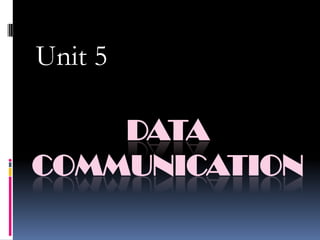
Data communcation
- 7. What is Data Communication...?? Data refers to information presented in whatever form is agreed upon by the parties creating and using the data. And Telecommunication means Communication at a distance.
- 8. So
- 9. Data communication is the exchange of data between two devices via some form of transmission medium such as a wire cable.
- 10. Characterstics of Data Communication Delivery Accuracy Timeliness Jitter
- 13. How does the Communication Takes Place….
- 14. Graham Betts
- 15. So, This is how Data moves around… --Data Source (where the data originates) --Transmitter (device used to transmit data) --Transmission Medium (cables or non cable) --Receiver (device used to
- 16. Data Flow
- 17. Figure 1.2 Data flow (simplex, half-duplex, and full-duplex) 1.17
- 18. NETWORKS A network is a set of devices (often referred to as nodes) connected by communication links. A node can be a computer, printer, or any other device capable of sending and/or receiving data generated by other nodes on the network. A link can be a cable, air, optical fiber, or any medium which can transport a signal carrying information. 1.18
- 19. Physical Structures Type of Connection Point to Point - single transmitter and receiver Multipoint - multiple recipients of single transmission Physical Topology Connection of devices Type of transmission - unicast, mulitcast, broadcast 1.19
- 20. Types of connections: point-to-point and multipoint 1.20
- 22. A fully connected mesh topology (five devices) --The mesh topology connects all devices (nodes) to each other for redundancy and fault tolerance. --It is used in WANs to interconnect LANs and for mission critical networks like those used by banks and financial institutions. --Implementing the mesh topology is expensive and difficult. 1.22
- 23. Advantages: •Fault tolerance •Guaranteed communication channel capacity •Easy to troubleshoot Disadvantages: •Difficulty of installation and reconfiguration •Cost of maintaining redundant link 1.23
- 24. A star topology connecting four stations --All the cables run from the computers to a central location, where they are all connected by a device called a hub. Each computer on a star network communicates with a central hub that resends the message either to all the computers or only to the destination computers. --Hub can be active or passive in the star network ----Active hub regenerates the electrical signal and sends it to all the computers connected to it. ----Passive hub does not amplify or regenerate signal and does not require electrical power to run. --We can expand a star network by placing another star hub. 1.24
- 25. Advantages: --Easy to modify and add new computers to a star net --Center of a star net is a good place to diagnose network faults --Single computer failure do not necessarily bring down the whole net --Several cable types can be used with the hub Disadvantages: --Central hub fails, the whole network fails to operate --Many star networks require a device at the central point to rebroadcast or switch network traffic. --Costs more for cabling in star net than bus. 1.25
- 26. A bus topology connecting three stations --All the devices on a bus topology are connected by one single cable. When one computer sends a signal up the wire, all the computers on the network receive the information, but only one accepts the information. The rest regrets the message. --One computer can send a message at a time. --A computer must wait until the bus is free before it can transmit. 1.26
- 27. Advantages The bus is simple, reliable in small network, easy to use and understand Requires the least amount of cable to connect the computers and less expensive Easy to extend the bus Disadvantages Heavy network traffic can slow a bus considerably Each barrel connector weakens the electrical signal Difficult to troubleshoot a bus 1.27
- 28. A ring topology connecting four stations --Each computer is connected to the next computer ,with the last one connected to the first. --Every computer is connected to the next computer in the ring, and each retransmits what it receives from the previous computer. --The message flow around the ring in one direction. -- Some ring networks do token passing. It passes around the ring until a computer wishes to send information to another computer. 1.28
- 29. Advantages: •No computer can monopolize the network •The fair sharing of the network allows the net to degrade gracefully as more user are added. Disadvantages: •Failure of one compute can affect the total network •Difficult to troubleshoot •Adding or removing Computers disrupts the network 1.29
- 30. Categories of Networks Local Area Networks (LANs) Short distances Designed to provide local interconnectivity Wide Area Networks (WANs) Long distances Provide connectivity over large areas Metropolitan Area Networks (MANs) Provide connectivity over areas such as a city, a campus 1.30
- 31. LAN (Local Area Network) A local area network (LAN) is usually privately owned and links the devices in asingle office, building, or campus. Depending on the needs of an organization and the type of technology used.
- 32. 5
- 33. WAN (Wide Area Network) A wide area network (WAN) provides long-distance transmission of data, voice, image, and video information over large geographical areas that may comprise a country, a continent, or even the whole world.
- 35. MAN (Metropolitan Area Network) A metropolitan area network (MAN) is designed to extend over an entire city. It may be a single network such as a cable television network, or it may be a means of connecting a number of LANs into a larger network so that resources may be shared LAN-to-LAN as well as device-todevice.